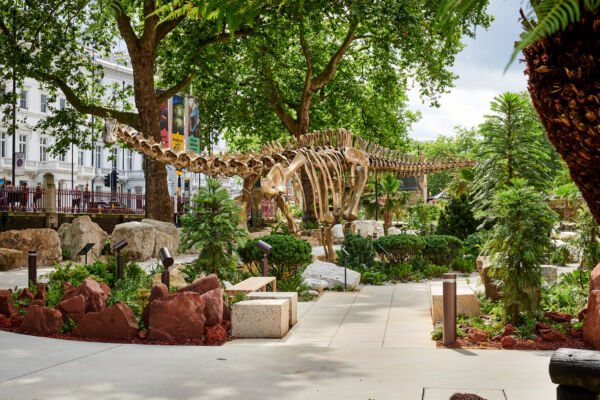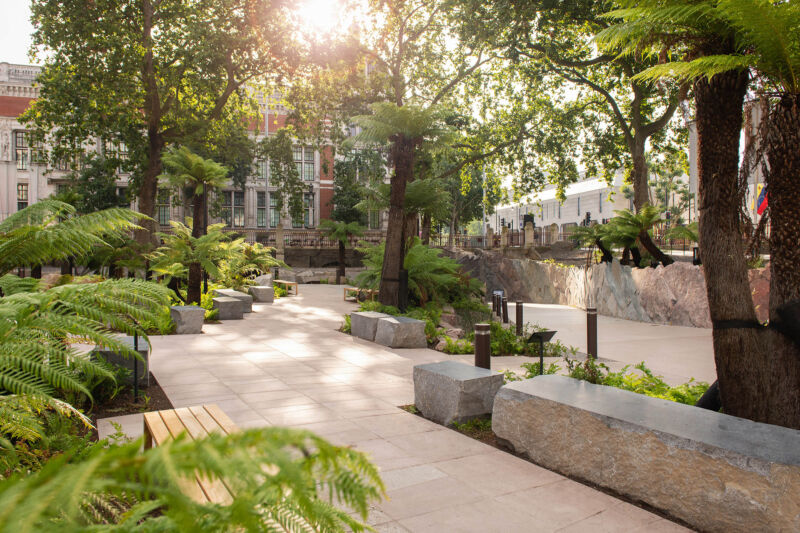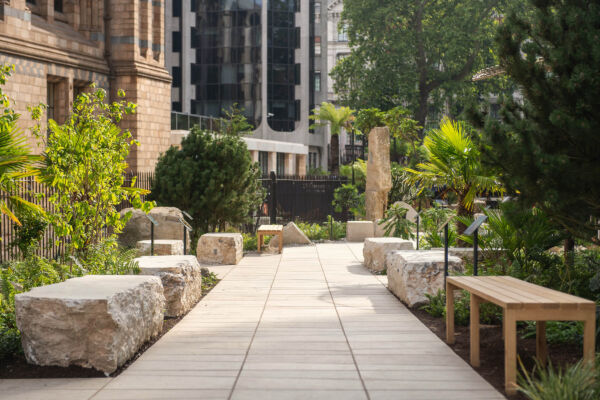
The Natural History Museum attracts over 6 million visitors annually and has recently reopened its gardens following a redesign of the 2-hectare site, transforming it into an engaging, fully accessible, and free-to-visit green space in the heart of London. The new Evolution Garden takes visitors through 2.7 billion years of Earth’s history via an immersive timeline featuring geology, plants and representations of animals in brass and bronze.
The entire garden is scaled to the Phanerozoic Eon, with 1 metre representing 5 million years. Geological periods are marked along the path with brass strips and represented in the landscape with rocks of the appropriate age. Over 30 different rock types are included, with all but two sourced from the UK. The gardens offer a chance to engage the public in novel ways, providing an understanding of the vast scale of geological time, illustrating some of the major changes in Earth’s flora and fauna, and establishing links between the evolution of life and geological processes.

The design team worked closely with Dr Paul Kenrick, a principal researcher at the Museum, to develop designs for the Evolution Garden. In addition we were supported by a number of key experts across the supply chain including CED, Szerlemey and Lazenby and numerous individuals who helped to source and negotiate access to some of the harder to source natural stone specimens, notably the geologist, the late Patrick Parker.
Visitors can enter the gardens via the subway tunnel entrance and begin their immersive experience in the Precambrian period. They are welcomed by the Evolution Timeline Wall, a distinctive landscape feature that rises to over 4.5m at its highest point, forming a canyon clad in the most ancient rocks from Scotland. The wall begins with Lewisian gneiss from the Western Isles, Torridonian sandstone from the Applecross Peninsula, and a greenschist from Argyll and Bute. Moving along the timeline, visitors encounter Cambrian quartzite from the Northwest Highlands in the Cambrian era, followed by Welsh purple and blue-grey slate, a light grey Ordovician granite from Aberdeenshire, a pink granite from the Highlands in the Silurian period, and a deep-red sandstone from Herefordshire in the Devonian, and so forth through the garden. As Dr Paul Kenrick explains “This geological sequence showcases some of the UK’s distinctive geodiversity and tells a story of the opening and closing of ancient ocean basins and the collisions of continents. These are geological process that have shaped our islands, lending character to some of their most distinctive terrains.”
The stone for the wall was hand-selected by Feilden Fowles and J&L Gibbons during several quarry visits across the UK. The cladding is made from stone ‘scants,’ which were sliced from the quarried blocks. Photographs were taken of each individual stone, and these were then used by Feilden Fowles to digitally arrange the pieces into the final layout. The stone contractor, Szerelmey, then created a dry-lay of the Timeline Wall for final adjustments before transporting it to the site and installing it.

The geological pieces that form the Timeline Wall gradually reduce in scale as visitors move through the gardens. From the Carboniferous period onwards, the wall is formed by boulders which also blend into the landscape with smaller pieces added that together with the living plants and sculptures tell a story of how life evolved. Additional rocks are incorporated into the landscape in various ways, from individual large boulders, to benches, the settings for interpretation and gravel mulch. There are seats provided throughout the gardens. Some of these seats have been hewn straight from the geology of the era, such as cooked chalk and flint, Grampian granite or Purbeck limestone.
The Evolution Garden also features a new pavilion building, the Garden Kitchen, which serves as a café, event space, and seasonal display area for more exotic plants. The main façade of the building is constructed from large 300mm deep blocks of Clipsham stone with a plinth of Purbeck Spangle. The horizontal layering of the elevations references the geological strata of the Timeline Wall as well as the layered terracotta façade of the original Waterhouse building.
This project was holistically planned and executed with sustainability at its core. Locally sourcing natural stone with low-embodied carbon was very important to meet sustainability targets, and this challenge also presented a wonderful opportunity to showcase the amazing breadth of geology found across the United Kingdom.

One of the ways we approached this was to source geology that might ordinarily be considered over burden or by-products from established stone extraction processes; such as glacial erratics that emerge from the sand and gravel quarrying processes of the north of Scotland; large format slate that might not be considered suitable for roofing applications from Penrhyn or cooked chalk and flint specimens that are occasionally found during the process of making chalk flour in Northern Ireland.
The plants have also been carefully positioned to create a sense of place throughout the Evolution Garden, immersing visitors in their evolutionary stories. At the start of the garden, mosses and liverworts have a starring role in the Ordovician Period. Large tree ferns feature in an ancient coal forest of the Carboniferous Period. Flowers appear later in the garden to reflect their origin during the Cretaceous Period. A corner of the garden is devoted to the Eocene Epoch when London experienced a subtropical climate. ‘Fern’, the name given to a bronze life-size Diplodocus cast, takes centre stage in its own Jurassic garden, surrounded by ferns, Wollemi pines, dwarf ginkgos and cycads—plants all chosen to evoke the feel of a landscape in the Jurassic Period. Grasses and flowers in the daisy family feature towards the end of the timeline to illustrate the spread of grasslands during the Neogene Period.
The pathways, constructed from poured terrazzo, are also designed to fit within the narrative of deep time, changing in appearance as visitors move along the timeline. The stone chips, which are ground down to form the final surface, have been chosen to correspond with the relevant geological period. Brass inlays represent fossils, geological eras, and processes such as extinction events. By the time the path reaches the Anthropocene period, elements of human life are visible, with shards of pottery and plastics embedded within the terrazzo mix. Visitors finish their journey along the timeline by walking over brass inlays of human footprints which mark the emergence of humans on earth.
Written by
Neil Davidson, J&L Gibbons
Edmund Fowles, Feilden Fowles

